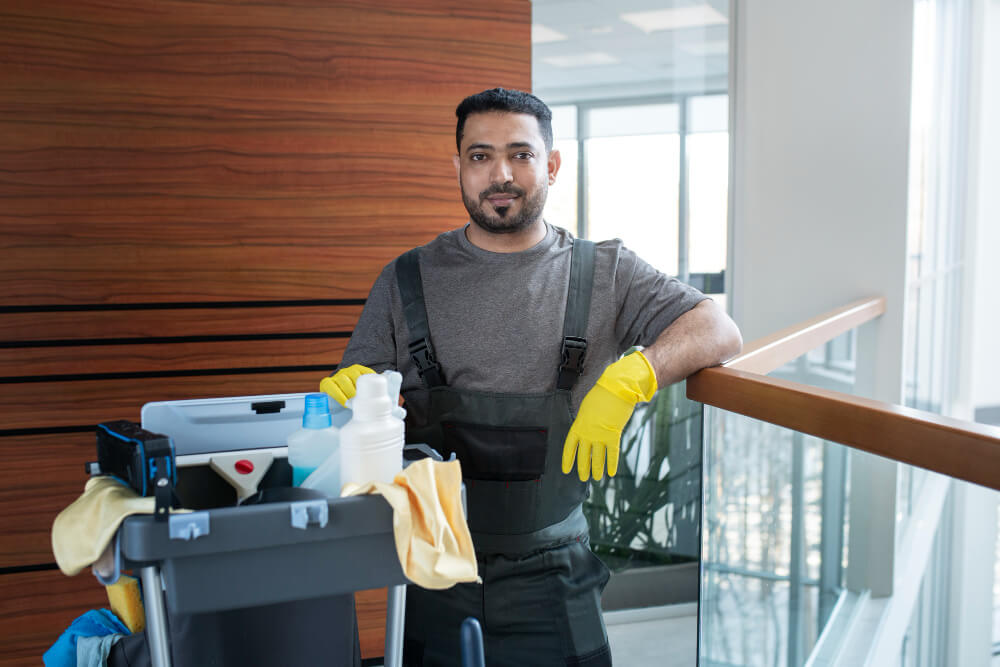A clean office isn’t just about aesthetics—it directly affects employee health, productivity, and overall well-being.
But keeping a workspace spotless all year long can feel overwhelming. How often should deep cleaning happen? What areas get overlooked? How do you maintain hygiene without disrupting daily operations? If you’re wondering how to maintain a clean and healthy workplace, a few key strategies can help streamline the process and keep your office fresh year-round.
This guide will walk you through practical, year-round office cleaning strategies to ensure a healthier and more productive workspace.

Why Year-Round Cleaning Matters
A neglected office can lead to increased sick days, poor air quality, and an unprofessional atmosphere.
Germs spread quickly in shared spaces, and clutter can contribute to stress. Implementing a consistent cleaning routine prevents these issues and helps maintain a welcoming environment for employees and clients alike.
Health Benefits of a Clean Office
- Reduces the spread of illnesses – Regular disinfection lowers the chances of colds, flu, and other contagious diseases spreading among employees.
- Improves indoor air quality – Dust, allergens, and mold spores can accumulate over time, triggering allergies and respiratory issues.
- Boosts mental well-being – A clean and organized space reduces stress, increases focus, and enhances overall morale.
- Promotes a professional image – A tidy office leaves a positive impression on clients and visitors, reinforcing a company’s credibility.
Daily Cleaning Habits for a Healthier Office
The foundation of a clean workspace starts with daily habits.
Simple, consistent efforts make a big difference in maintaining hygiene and preventing messes from piling up.
- Disinfect high-touch areas – Wipe down doorknobs, keyboards, light switches, and shared equipment daily to reduce germ transmission.
- Empty trash bins regularly – Overflowing bins lead to unpleasant odors and attract pests.
- Encourage desk cleanliness – Provide employees with disinfecting wipes and encourage them to keep their personal spaces tidy.
- Keep shared spaces organized – Break rooms, conference rooms, and reception areas should be cleaned daily to maintain a professional atmosphere.
- Check for spills and stains – Addressing spills immediately prevents staining and reduces slip hazards.
- Stock hygiene supplies – Ensure restrooms are well-stocked with soap, paper towels, and hand sanitizer.
Weekly Deep Cleaning Tasks
Some tasks don’t need daily attention but should be addressed weekly to maintain hygiene and order.
- Vacuum carpets and mop floors – Reduces dust buildup and improves air quality.
- Sanitize office kitchen and break areas – Wipe down countertops, clean out the fridge, and sanitize the microwave.
- Dust surfaces and vents – Accumulated dust can trigger allergies and respiratory issues.
- Check restrooms – Ensure thorough cleaning of sinks, toilets, and floors to maintain hygiene standards.
- Clean office furniture – Wipe down desks, chairs, and cabinets to prevent dust accumulation.
- Refresh indoor plants – Remove dead leaves, check for pests, and wipe plant leaves to improve air quality.
Monthly Office Cleaning Priorities
A few areas need less frequent but thorough attention to prevent long-term buildup of dirt and grime.
- Deep clean carpets and upholstery – Helps remove stains and allergens.
- Wipe down walls and windows – Keeps the office looking bright and professional.
- Declutter and organize storage areas – Prevents unnecessary buildup of paperwork and supplies.
- Check and replace air filters – Improves air quality and reduces allergens.
- Polish wooden surfaces – Keeps desks, tables, and shelves in good condition.
- Inspect for maintenance issues – Look for leaks, cracks, or damage that might need repairs.
Seasonal Cleaning for a Fresh Start
Each season presents unique cleaning challenges.
A targeted approach ensures that your office remains fresh and functional year-round.
- Spring: Declutter workstations, deep clean carpets, and introduce fresh air circulation.
- Summer: Prevent mold and mildew in humid months by checking ventilation and moisture-prone areas.
- Fall: Clear out clutter before the holiday rush, refresh upholstery, and clean out HVAC systems.
- Winter: Disinfect common areas more frequently as flu season peaks, and keep entryways clean from mud and moisture.
Spring Cleaning Tips
- Deep clean workstations, including under desks and behind electronics.
- Organize supply closets and get rid of outdated or broken items.
- Wash office curtains or blinds to remove dust and allergens.
Summer Cleaning Tips
- Ensure air conditioning units are clean and functioning properly.
- Increase ventilation in humid areas to prevent mold growth.
- Deep clean restrooms to eliminate bacteria and odors caused by heat.
Fall Cleaning Tips
- Prepare heating systems for colder months by cleaning vents and filters.
- Declutter desks before the busy holiday season.
- Disinfect shared spaces more frequently to prevent seasonal illnesses.
Winter Cleaning Tips
- Focus on disinfecting common touchpoints like doorknobs and handrails.
- Use mats at entrances to trap moisture and dirt from shoes.
- Regularly clean and dry office floors to prevent slips and falls.

Creating a Culture of Cleanliness
A clean office is a team effort. Encouraging employees to take responsibility for their workspace fosters a cleaner and healthier environment.
Here’s how:
- Provide cleaning supplies – Keep disinfecting wipes, hand sanitizers, and paper towels easily accessible.
- Set clear expectations – Establish simple cleaning guidelines that all employees can follow.
- Reward cleanliness – Acknowledge and appreciate employees who help maintain a tidy workspace.
- Encourage personal hygiene – Promote handwashing and responsible food storage in office kitchens.
- Host a cleaning challenge – Make cleaning fun with a friendly competition or incentive program.
Working with Professional Cleaning Services
For thorough and specialized cleaning, consider hiring a professional service.
Here’s what to look for:
- Experience and reputation – Check reviews and ask for references.
- Use of eco-friendly products – Green cleaning supplies reduce exposure to harsh chemicals.
- Customizable plans – Ensure they offer flexible cleaning schedules tailored to your needs.
- Proper certifications – Verify they meet industry standards for commercial cleaning.
Final Thoughts
A clean office isn’t just about appearances—it’s about fostering a workspace that promotes health, productivity, and overall well-being.
By implementing year-round office cleaning strategies, you can reduce the spread of illness, improve air quality, and create an environment where employees feel comfortable and focused.
The key to maintaining a spotless office lies in consistency. Daily habits like disinfecting high-touch areas and keeping shared spaces tidy prevent messes from piling up.
Weekly deep cleaning tasks ensure that dust and germs don’t accumulate, while monthly and seasonal cleaning efforts tackle the bigger issues that can impact workplace hygiene.
Encouraging a culture of cleanliness among employees and working with professional cleaning services can make the process even smoother.
With a little planning and teamwork, maintaining a fresh and healthy office space becomes second nature.
What strategies have worked best for your workplace? Share your experiences in the comments or pass this guide along to your team to help everyone stay on top of office cleanliness year-round!





